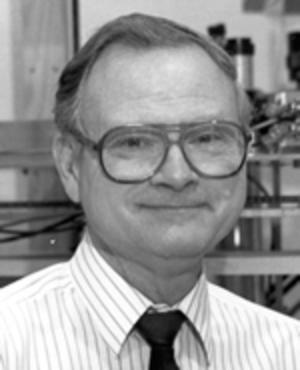
Rue Linn Belford was born in St. Louis, Missouri on December 13, 1931 to the late Rue L. Belford and Fannie Belford (neé Kelley). His family moved numerous times throughout the Depression as his father sought work: Bayview, Texas; Cleveland, Ohio; and one year in Lower Merion, Pennsylvania, where in that short period of time he met his future wife, Geneva Grosz. Linn obtained his bachelor’s degree in chemistry from the University of Illinois in 1953. He carried out undergraduate research with Professor Peter Yankwich on the temperature coefficient of the intermolecular 13C kinetic isotope effect in the decarboxylation of malonic acid. Right from the start, Linn had a knack for research: his undergraduate work led to no less than four papers in the Journal of the American Chemical Society.
In 1954, Linn and Geneva were married in Bryn Mawr, Pennsylvania and, together, made the trek across the country to Berkeley, California. It was there that Linn received his PhD degree from Berkeley in 1955 under the direction of future Nobel Laureate Melvin Calvin. His thesis concerned the bonding and spectra of transition metal chelates, and it was during this period that he began his lifelong studies of electron paramagnetic resonance (EPR). Geneva's mathematical skills enabled her to collaborate with Linn in his EPR studies at Berkeley and led to their being co-authors on a paper, the first of many such collaborations.
At the unusually young age of 23, Linn joined the faculty at the University of Illinois. Initially hired as an instructor, he was promoted to assistant professor in 1957, to associate professor in 1963, and then to professor in 1981. At Illinois, Linn exploited special electronic and EPR spectroscopic techniques to characterize transition metal ions, radicals, biomolecules, and catalytic surfaces. He became one of the world’s leading experts in the application of EPR spectroscopy to problems in physical, biophysical, and inorganic chemistry. His research interests included anisotropies in solid-state structure and spectra, the development of contrast agents for MRI, nuclear quadrupole and spin-spin interactions, fast (picosecond) dynamics in condensed phases, dynamic nuclear polarization, and EPR theory. He was particularly noted for his use of EPR techniques such as electron-nuclear double resonance, electron spin echo, and low-to-high frequency EPR to determine structures and dynamics in disordered solids such as coal. In the latter studies, he employed EPR frequencies (and magnetic field strengths) varying over two orders of magnitude. He also was a pioneer in the use of EPR to study protein folding and metallaprotein structures, catalytic surfaces and internal interfaces in materials, and paramagnetic sensors for oxygen and nitric oxide.
For many years Linn was Director of the Illinois EPR Research Center, which was founded in 1985 under a grant from the National Institutes of Health. While Director, he oversaw the development of the world's first S-band (2 to 4 GHz) pulsed EPR, which is particularly useful in the study of very weak interactions between free radicals or transition metal ion and a remote atom. Much attention was given to developing methods to carry out computer simulations of complex spectra, which required new theories and improvements on traditional computational methods.
In addition to his significant work in EPR spectroscopy, Linn had a separate project on shock-tube methods to study high-temperature fast reactions. He began to use ultraviolet absorption spectroscopy in reflected shock waves to resolve uncertainties in the equilibrium thermodynamics of linear triatomic molecules and to understand the reaction kinetics of linear triatomic molecules that are isoelectronic in their valence shells (CSe2, CO2, CS2, OCS, N2O). His work in this field was published from the 1960s to about 1980. His paper explaining how to correct for the effects of boundary layer conditions on temperature is used by every practitioner in the shock tube field.
In addition to over 150 research publications, Linn wrote one book, “Spectroscopy and Photochemistry of Uranyl Compounds,” (1964) with Illinois Professor of Botany Eugene I. Rabinowitch; it was also translated into Russian. Among his many awards and honors, Linn received an NSF Predoctoral Fellowship in 1954-1955, and an Alfred P. Sloan Fellowship in 1961-1963. From 1965 until 1969 he was an NIH Fellow and from 1966-1967 he was an NIH Senior Fellow in biophysics and biophysical chemistry. In 1988, Linn received the John R. Kuebler Award of Alpha Chi Sigma; this is the highest award given by this professional chemistry fraternity, and is bestowed on one of its members for outstanding service to the Fraternity, outstanding service to the profession, or accomplishment in the science of chemistry. In 2002, he received the Gold Special Medal for Distinguished Service from the International EPR Society. Linn retired in 2005 after 50 years on the active faculty; no other faculty member in the history of the chemistry department at Illinois has served as many years on the active staff.
Linn and Geneva, who was a professor in the Department of Computer Science, were an inseparable pair. They shared the daily commute to the University from Mahomet for nearly five decades, and had lunch together in Campustown every day possible. They enjoyed traveling together, particularly to Colorado every summer, where, when Linn wasn’t attending the Rocky Mountain EPR Conference, they would take long hikes together in the mountains. They both retired to their home in Mahomet until March, 2014, when after 60 years of marriage, Linn lost Geneva to a lengthy illness. Although missing his other half, Linn hung on stoically until August 14, 2015, when he passed away peacefully at home. In addition to the countless students whose lives he touched, Linn is survived by two nieces: Dr. Kathleen Robins, Associate Professor of Physical Chemistry at the University of Nevada Las Vegas, who counted Linn among her greatest mentors; and Dr. Cynthia Robins, a Senior Study Director at Westat in Rockville, Maryland, who became a cultural anthropologist with the full support of her uncle. Many lives are richer for having known Linn Belford, and he will be sorely missed.